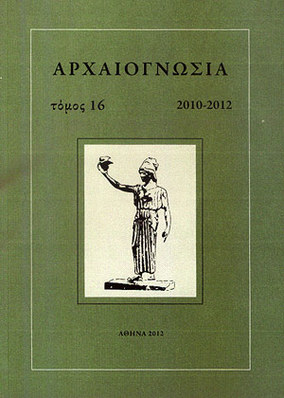Τα αρχαία λατομεία της Προκοννήσου στην Προποντίδα
Part of : Αρχαιογνωσία ; Vol.13, No.1, 2005, pages 155-196
Issue:
Pages:
155-196
Parallel Title:
The ancient quarries of Prokonessos
Section Title:
Σύμμεικτα
Author:
Abstract:
The ancient quarries of Prokonessos, in the Sea of Marmara, are located on thenorthern part of the island, at the vicinity of Saraylar (Palatia) town. As chemical analyses have proven, their activity begins since the archaic period when material was provided for sculpture on the opposite coasts also (e.g. the kouroi from Raedestos, Kyzikus etc.). During the classical period they provide Kyzikus with marble which is also used for the construction of the most important and the remotest monuments of that era (e.g. the Maussoleum of Halikarnassus). In the Hellenistic time the wide extraction of Prokonessian marble is a given fact, mostly exploited for the sculpture and architecture of the Attalid kingdom (e.g. the Telephos frieze on the Great Altar at Pergamos, the Stoa of Eumenes at Athens, etc.). In the Roman imperial era the quarries are reorganized within the frame of the roman marble trade system and the works are carried out under the supervision of a roman commissioner who settles on the island. During the late Roman period the production of architectural elements (capitals, columns and column bases), sarcophagi and sculpture is systematized in order to meet the ever growing demand for cheap — according to the edict of Deocletian — Prokonnessian marble for the civil centers of the empire. The Ward Perkins’ theory which claims that this marble was carved and traded by the Nikomedian workshops has yet to be verified by archaeological evidence. The exploitation rate of Prokonnessian marble does not change in the Early Christian period, when the legislation of Theodosius the Great supported the systematic operation in order to build the capital of the empire, Constantinople. At the time of Justinian and during the renewal of the relative state laws the Prokonnessian quarries provide construction material for the new buildings of Constantinople. The Prokonnessian architectural members travelled half-finished and were given their final form at the location where they were going to be used (cf. the Sile shipwreck in the Black Sea), while the half-finished Proconnessian capitals are variously sculpted at their final destination (basket-, roofed-over-, lyre- shaped etc.). The Prokonnessian sarcophagi are spread all over the Mediterranean basin and are copied even while they were half-finished. The quarrying activity awakens only during the Post-Byzantine period, due to the second use of spolia in the contemporary structures and is intensified once again in the Ottoman era, when they are utilized for the construction of mosques. The quarries operated also in the modern era (19th-20th c.), thus leaving behind an important monument, the marble factory at Panormi.
Subject:
Subject (LC):
Keywords:
αρχαϊκή εποχή , Χαλκιδική
Notes:
Περιέχει εικόνες, Η συγγραφή του κειμένου και η έρευνα στη βιβλιοθήκη πραγματοποιήθηκαν από την Ειρήνη Πουπάκη. Στην ομάδα συμμετείχαν εκτός από τους υπογράφοντες το παρόν άρθρο και οι ακόλουθοι μεταπτυχιακοί φοιτητές Κλασικής Αρχαιολογίας: Βάσια Ψηλακάκου, Τάνια Πανάγου και Γιώργος Βήτος. Θερμές ευχαριστίες οφείλουμε στη δρ. N. Asgari που μας διευκόλυνε στην πραγματοποίηση της επίσκεψής μας και επέτρεψε τη δημοσίευση των περιλαμβανομένων φωτογραφιών από τα λατομεία και ημίερχων αντικειμένων από τα υπαίθρια μουσεία του νησιού. Η συμβολή της κυρίας Asgari στην έρευνα των λατομείων της Προκοννήσου είναι θεμελιακή. Επίσης, ευχαριστίες στην καθ. Βυζαντινής Αρχαιολογίας του Πανεπιστημίου Αθηνών, κ. Σ. Καλοπίση-Βέρτη για τις υποδείξεις της σχετικά με τους παλαιοχριστιανικούς- βυζαντινούς χρόνους. Το παρόν κείμενο αποτελεί σύνθεση όλων των στοιχείων που έχουν έως σήμερα έρθει στο φως ή έχουν προκόψει από την έρευνα σχετικά με την ιστορία του νησιού και ειδικότερα την ιστορία των λατομείων του. Μέρος της παρούσας μελέτης, που αφορά μόνον στην παραγωγή των λατομείων κατά τους αρχαϊκούς και κλασικούς χρόνους,παρουσιάστηκε σε πινακίδα (poster) στο 10ο Διεθνές Συνέδριο Θρακολογίας, Κομοτηνή — Αλεξανδρούπολη, 18-23 Οκτωβρίου 2005.




